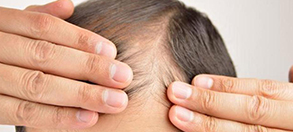Most of us don’t think much about our hair until thinning or baldness becomes a threat. We don’t realize how much of our identity is tied into this one physical feature. When we experience hair loss, it can cause a significant drop in self-esteem. Medical hair loss can be the result of a variety of causes. Male pattern baldness, genetics, medications, and illnesses can lead to hair loss or thinning. Fortunately, there are a number of medical hair restoration options currently available to combat baldness and thinning hair.
Contents
Some Hair Loss is Normal
All of us experience some degree of hair loss throughout our lives. Our hair experiences a continuous growth cycle and every hair on our heads will be shed at some point. During any phase of this cycle, at least 85 to 90 percent of our hair is constantly growing for a period of two to eight years. This phase is referred to as the anagen phase. Another smaller percentage of our follicles is in the catagen phase, which is a transitional period that lasts approximately two months. The remaining hair follicles are resting, in the telogen phase that lasts about two to three months. After this resting phase, the hair is shed and new hair takes its place to restart the growing phase. Hair grows at a rate of about a half-inch each month, but this growth slows down as we start to age. Since most of us shed about 50 to 100 hairs each day, this normal hair loss should not be cause for alarm. However, if there appears to be a significant amount of thinning, it may be time to consult a specialist to discuss medical hair loss prevention and possible medical hair restoration treatment options.
Male Pattern Baldness
Male pattern baldness, also known as androgenetic alopecia, is the number one cause of thinning hair in more than 95 percent of hair loss cases. The genes responsible for this can be inherited from either parent, and it can affect both sexes. Hair loss prevention is a huge concern for those of us who have a family history of baldness. Fortunately, medical hair loss treatment options are readily available.
Causes of Male Pattern Baldness
Age, genetics, and a hormone called dihydrotestosterone (DHT) are three factors that influence male pattern baldness. Those of us who have DHT-sensitive follicles experience follicle shrinking due to the high levels of DHT in the scalp. Over time, hair becomes thinner and loses pigmentation. Additionally, hair growth phases and follicles become shorter and individual hair strands are prevented from growing to a full length. Finally, some follicles die and any remaining hairs eventually resemble peach fuzz. Hair growing on the sides of the head and the lower rear portion of the head are not affected by DHT. This is wonderful because these sections are used for hair transplantation.
Preventing Hair Loss
Hair loss affects millions of men in the United States. Hair loss treatment options for men include hair restoration products and hair transplant options. These options may include FUE techniques such as Neograft or Artas. Medical hair restoration cost may vary according to the type of procedure selected and the severity of thinning.
Hair Loss Treatment Products
There are numerous products on the market that claim to cure hair loss, but there are only two FDA-approved hair restoration treatments available. These products are considered to be effective in preventing hair loss and on occasion may help some of us regrow lost hair. However, these products must continue to be used once treatment begins or new hair will fall out. Thankfully, there are more permanent treatment options available to reduce thinning hair.
Hair Restoration Treatments
Surgical hair restoration treatment involves a group of surgical hair loss treatments that are intended to reduce or eliminate thinning hair or baldness. There are numerous hair replacement procedures that a doctor may use to accomplish this. These treatments may include FUT strip, Artas, or Neograft.
There have been significant advancements in hair restoration treatments in the past ten years. Some of the procedures available now have been recently developed and are considered to be on the cutting edge of technology. Success levels have improved, and recovery time has been greatly reduced. The medical hair restoration cost has also gone down, making this option a reality for many more men than in previous years.
Hair loss and thinning may be a reality for many of us. However, this doesn’t mean that we have to sit back and accept the genetic roulette that has left us in this predicament. We’re no longer at the mercy of genetics. Medical hair loss treatment can be safe and effective, and lots of men are taking charge of their hair loss and reviving their follicles with surgical hair restoration.


